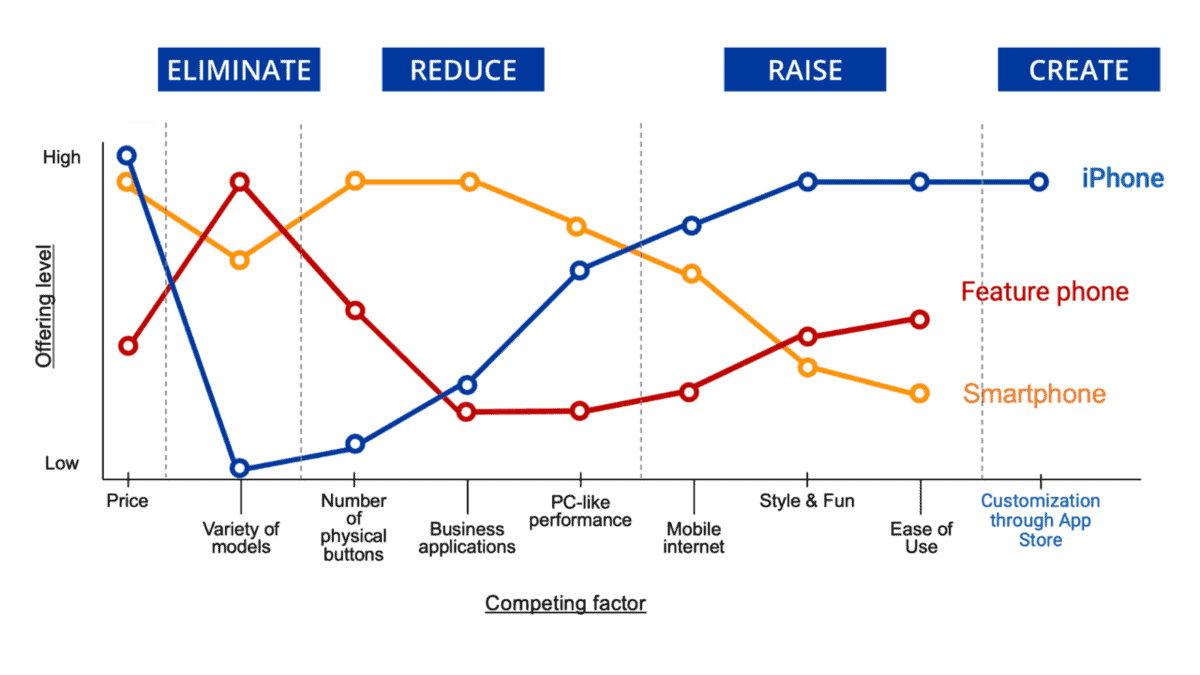What is Blue Ocean Strategy
The Blue Ocean Strategy is a strategic business approach developed by W. Chan Kim and Renée Mauborgne, which was introduced in their book “Blue Ocean Strategy: How to Create Uncontested Market Space and Make Competition Irrelevant.” This strategy focuses on creating new market spaces or “blue oceans” that are uncontested by competitors, as opposed to competing in crowded and highly competitive “red oceans.”
Here are some key principles and concepts of the Blue Ocean Strategy:
Red Oceans vs. Blue Oceans: Red oceans represent existing markets where companies compete fiercely for market share. These markets are often saturated, with many players offering similar products or services. In contrast, blue oceans are untapped or underexplored market spaces where competition is minimal or non-existent.
Value Innovation: Blue Ocean Strategy emphasizes the concept of “value innovation.” This means creating products or services that offer both higher value to customers and lower costs to the company, thus breaking the traditional trade-off between cost and differentiation.
Focus on Customer Needs: The strategy places a strong emphasis on understanding customer needs and preferences and tailoring products or services to meet those needs effectively. This often involves “reconstructing market boundaries” by adding new features or elements that resonate with customers.
Eliminate, Reduce, Raise, Create (ERRC) Grid: To identify opportunities for value innovation, companies can use the ERRC grid. This tool helps organizations evaluate factors they can eliminate, reduce, raise, or create in their products or services compared to existing offerings.
Four Actions Framework: This framework encourages businesses to ask four critical questions to shape their blue ocean strategy:
- What factors can be eliminated that the industry has long competed on?
- What factors can be reduced below industry standards?
- What factors can be raised well above industry standards?
- What factors can be created that the industry has never offered?
Visual Strategy Canvas: A visual representation that helps organizations compare their current strategy with the proposed blue ocean strategy. It allows for a clear visual assessment of the value and cost elements relative to competitors.
Execution and Adaptation: Implementing a blue ocean strategy often involves significant changes within an organization. It requires commitment and the ability to adapt to new market dynamics and customer needs.
Blue Ocean Strategy has been applied in various industries and has resulted in the creation of successful, disruptive businesses. It encourages companies to look beyond traditional competition and explore innovative ways to create new demand and make their competition irrelevant by offering unique value propositions to customers. However, it’s important to note that finding and successfully exploiting blue oceans can be challenging, and not all attempts will lead to market success
Blue Ocean Strategy of iPhone
The iPhone, when it was first introduced by Apple in 2007, is a classic example of a Blue Ocean Strategy. Apple essentially created a new market space for smartphones by combining various functionalities and design elements that were not typically found in mobile phones at the time. Let’s analyze this using the ERRC Grid, Four Actions Framework, and a simplified Visual Strategy Canvas:
ERRC Grid
Eliminate:
- Physical Keyboard: Eliminate the physical keyboard found on most mobile phones, which made devices bulky and limited screen size.
- Stylus: Eliminate the need for a stylus or stylus-based input, simplifying the user experience.
- Limited App Ecosystem: Eliminate the restrictions on third-party apps, opening up a vast ecosystem for developers to create apps.
Reduce:
- Button Clutter: Reduce the number of physical buttons on the device, simplifying the design.
- Hardware Complexity: Reduce the complexity of hardware components by integrating functionalities like the iPod, camera, and phone into a single device.
- Learning Curve: Reduce the learning curve for users by creating an intuitive touch interface.
Raise:
- User Interface: Raise the bar for user interface design with a touch screen that allows intuitive gestures and interactions.
- Web Browsing: Raise the quality of web browsing by introducing a mobile Safari browser with full-page rendering.
- App Ecosystem: Raise the app ecosystem by allowing third-party developers to create innovative applications.
Create:
- Multi-Touch Interface: Create a revolutionary multi-touch interface that enables pinch-to-zoom, swipe gestures, and other natural interactions.
- App Store: Create the App Store, a platform for downloading and installing a wide variety of third-party applications.
- Seamless Integration: Create seamless integration with iTunes, allowing users to sync music, photos, and videos effortlessly.
Four Actions Framework
Eliminate: By eliminating physical keyboards, styluses, and restrictions on third-party apps, Apple reduced the clutter and limitations of traditional mobile phones.
Reduce: Reducing physical buttons, hardware complexity, and the learning curve made the iPhone more user-friendly and appealing to a broader audience.
Raise: Apple raised the bar with its user interface, web browsing experience, and the app ecosystem, setting new industry standards.
Create: The creation of the multi-touch interface, the App Store, and seamless integration with iTunes set the iPhone apart as a groundbreaking and integrated device.
Visual Strategy Canvas
The iPhone’s Blue Ocean Strategy in 2007 transformed the mobile phone industry by offering a device that was not just a phone but a multi-functional, user-friendly, and innovative tool, creating an entirely new market space.
Blue Ocean Strategy for Health Insurance
Creating a blue ocean in the health insurance industry can be challenging due to its highly competitive nature. However, there are opportunities to differentiate and innovate within this sector. Let’s explore an example of a hypothetical health insurance company’s blue ocean strategy using the ERRC Grid, Four Actions Framework, and Visual Strategy Canvas:
ERRC Grid
Eliminate:
- Traditional Network Restrictions: Eliminate restrictive network structures that limit access to specific doctors or hospitals. This can reduce administrative costs and improve customer satisfaction.
- Complex Policy Language: Simplify policy language and eliminate jargon to make health insurance easier for customers to understand.
Reduce:
- Paperwork and Administrative Burden: Reduce the paperwork and administrative hassles for both healthcare providers and policyholders by implementing efficient digital processes.
- Premium Costs for Healthy Lifestyles: Reduce premiums for policyholders who engage in healthy lifestyles, such as regular exercise, healthy eating, and preventive screenings.
Raise:
- Telehealth and Preventive Care: Raise the importance of telehealth services and preventive care by offering free virtual consultations and covering preventive screenings and vaccinations at 100%.
- Customer Support and Education: Invest in personalized customer support and education to help policyholders make informed healthcare decisions.
Create:
- Customized Health Plans: Create personalized health insurance plans that allow policyholders to choose the coverage options and services that best suit their needs.
- Wellness Rewards Program: Create a wellness rewards program that incentivizes policyholders to engage in healthy behaviors and earn discounts or rewards.
Four Actions Framework
Eliminate: By eliminating traditional network restrictions and complex policy language, the company reduces barriers to accessing healthcare and improves the customer experience.
Reduce: The reduction of paperwork and administrative burdens, as well as premium costs for healthy lifestyles, makes health insurance more affordable and convenient for policyholders.
Raise: By emphasizing telehealth, preventive care, and customer support, the company raises the value of its health insurance offerings and enhances the overall healthcare experience for policyholders.
Create: The creation of customized health plans and a wellness rewards program allows policyholders to have more control over their coverage and encourages healthy behaviors.
Visual Strategy Canvas

This strategy aims to create a blue ocean by offering a simplified, customer-centric, and personalized health insurance experience that addresses pain points and encourages healthier lifestyles. The company differentiates itself by focusing on prevention, convenience, and value, ultimately attracting a new segment of health-conscious consumers while retaining traditional policyholders.
Blue Ocean Strategy for Motor Insurance
Creating a blue ocean in the motor insurance industry, which is traditionally highly competitive and price-sensitive, requires innovative approaches to stand out and attract a new segment of customers. Here’s a hypothetical example of a motor insurance company’s blue ocean strategy using the ERRC Grid, Four Actions Framework, and Visual Strategy Canvas:
ERRC Grid
Eliminate:
- Paperwork and Documentation Hassles: Eliminate the need for extensive paperwork and documentation in the claims process by leveraging digital technologies for streamlined claims processing.
- Fixed Premiums: Eliminate fixed premium structures and introduce dynamic, usage-based pricing to reward safe driving behavior.
Reduce:
- Traditional Risk Factors: Reduce the reliance on traditional risk factors (e.g., age, gender) in determining premiums, focusing more on real-time driving data.
- Claims Processing Time: Reduce claims processing time through automation and faster response times.
Raise:
- Customer Experience: Raise the overall customer experience by offering 24/7 access to customer support, personalized policy recommendations, and online driver safety courses.
- Transparency: Increase transparency by sharing real-time driving data with policyholders and offering insights into how driving behavior impacts premiums.
Create:
- Connected Car Ecosystem: Create a connected car ecosystem that integrates with policyholders’ vehicles, providing real-time data on driving behavior, maintenance alerts, and safety tips.
- Gamified Safe Driving Rewards: Create a gamified rewards program where policyholders earn points or discounts for safe driving habits and responsible vehicle maintenance.
Four Actions Framework
Eliminate: By eliminating paperwork hassles and introducing dynamic pricing, the company reduces customer frustration and offers a more flexible and fair insurance experience.
Reduce: Reducing reliance on traditional risk factors and claims processing time makes the insurance process simpler and quicker, enhancing the customer experience.
Raise: The company raises the customer experience by providing continuous support and transparency, fostering a sense of trust and engagement.
Create: The creation of a connected car ecosystem and a gamified safe driving rewards program establishes a unique value proposition that goes beyond traditional motor insurance offerings.
Visual Strategy Canvas

This strategy aims to create a blue ocean by offering a more convenient, fair, and engaging motor insurance experience. By leveraging technology, data, and gamification, the company attracts a new segment of tech-savvy, safety-conscious drivers while challenging the norms of the traditional motor insurance industry.
Note: In case you are looking for a Product Management course, I would highly recommend joining this cohort-based course – ISB Executive Education – Product Management program
PS: You can connect with me for review or referral discount (link for referral discount)



